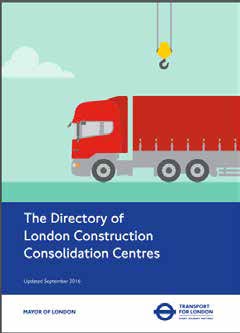Primer for Improved Urban Freight Mobility and Delivery
|
||
Key Accomplishments
|
In recent years, the city of London has experienced a boom in construction, resulting in a significant number of construction-related truck trips in the city each day. According to Transport for London (TfL), the city's transportation agency, the construction industry generates 35 percent of London's daytime truck traffic and 38 percent of all traffic during the morning rush hour. To reduce the volume and impacts of construction-related vehicle movements, TfL has developed a multi-faceted construction logistics program, which focuses on the safety risks posed by construction vehicles traveling on city streets. Two elements of the program, construction logistics plans (CLPs) and construction consolidation centers (CCCs), focus on the traffic impacts of construction logistics.
The City of London and many of the boroughs that make up greater London require that proposals for certain types of construction must be accompanied by a construction logistics plan (CLP). A CLP must include details on the expected levels of construction traffic that will be generated by the project, the routes that traffic will use, and measures the developer will take to reduce traffic impacts during construction of the project.
TfL has published guidance so that planning authorities and developers have a mutual understanding of what a high-quality CLP should include. This guide describes a menu of "planned measures," which are specific techniques for reducing or otherwise managing construction-related trips that developers commit to use during the planning permission process. TfL has also developed a two-day training course in construction logistics planning. This training brings together all of the key stakeholders involved in the drafting, approval, and implementation of a CLP and educates them about the range of planned measures that are available.
One of the benefits that TfL has seen from the use of CLPs is that planning authorities can better assess the potential cumulative traffic impacts of multiple construction projects being proposed for a particular part of the city. Another benefit of CLPs is that it generates discussion of potential traffic impacts of a project at the time that developers are seeking legal permission to build. It is at this time that developers are most willing to agree to take steps to reduce vehicle trips.
U.S. cities typically require developers of larger projects to prepare transport control plans.

Cover of the Tfl directory of CCCs. Source: TfL.
These plans typically elaborate how a developer will manage the flow of traffic around the construction site. The plans also identify the routes that vehicles will take to and from the site. However, they differ from CLPs in that they generally do not require a developer to consider ways to reduce the number of vehicle trips generated by a construction project.
CCCs are one of the planned measures or management techniques promoted by TfL. Consolidation centers are facilities where the freight shipments that are destined for a facility, site, or limited geographical area are collected and then delivered as consolidated loads. The purpose of adding a consolidation center into the freight distribution network is to reduce the number of "last-mile" vehicle trips by different carriers to the target destination. In the case of CCCs, the freight in question is building material, and the target destinations are construction sites.
In addition to consolidating shipments, CCCs can offer a number of additional services to builders, such as short-term storage of materials, pre-fabrication of building components, security screening, and reverse logistics (i.e., management of waste). CCCs can also serve as a queuing area for vehicles that are already fully loaded, which is helpful in cases in which there is a shortage of space for vehicles to wait near the construction site.
London and other cities in Europe have used or considered temporary CCCs for specific large development projects. In London, CCCs were used successfully for construction at Heathrow Airport and for preparations for the 2012 London Olympics. However, unlike in other European cities, London now has numerous CCCs that are operating on an ongoing basis without public subsidies. According to TfL staff, London's CCCs generally receive their revenue from the developers and the costs amount to roughly two percent of the cost of the development. However, the cost depends on the exact mix of services provided by the CCC.
To promote the use of these facilities, TfL published its first directory of CCCs in 2015. That first edition identified nine CCCs operating in or near London. Updated in fall 2016, the directory now lists 12 CCCs. The TfL directory provides details on each CCC, including capacity, location, and contact details. It also includes a map that shows the areas of London that are within a 30-minute drive of a CCC. TfL hopes that by showing the geographic reach of CCCs, the directory will spur greater usage of them. The map also shows the market potential in parts of the city not currently within a half-hour's drive of an existing CCC.
Peter Binham, Freight and Fleet Program Manager, Transport for London, 020 3054 6072, peterbinham@tfl.gov.uk
|
United States Department of Transportation - Federal Highway Administration |
||